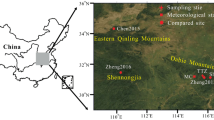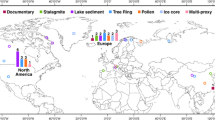Abstract
Using historical records on first and last frost and snow, spring cultivation, David peach blossom, autumn crop harvest, grade of sea freeze and change in northern citrus boundary, we reconstructed temperature change during 601–920 AD. The mean temperature of the winter half-year (October to April) over Central East China during this period was about −0.22°C higher than that of the present (1961–2000 AD mean). During 601–820 AD, mean temperature was about −0.52°C higher than the present. During 821–920 AD, the mean temperature was 0.42°C lower than the present. The temperature fluctuations were characterized by a maximum amplitude of 1.05°C at the centennial scale, 1.38°C at the 50–year scale, 2.02°C at the 30-year scale, and 2.3°C at the 20-year scale. There were four peaks warmer than today (601–620 AD, mean of 1°C higher temperature; 641–660 AD, 1.44°C; 701–720 AD, 0.88°C; 781–800 AD, 0.65°C). Three cold periods were in 741–760, 821–840, and 881–900 AD, the mean temperature of which was 0.37–0.87°C lower than the present.
Similar content being viewed by others
References
International Geosphere-Biosphere Programme (IGBP). PAGES Science Plan and Implementation Strategy. Stockholm: IGBP Secr, 2009. 57, 77
IPCC. Climate Change 2007: The Physical Science Basis, Contribution of Working Group I to the Fourth Assessment Report of the Intergovernmental Panel on Climate Change. Cambridge, United Kingdom and New York, USA: Cambridge University Press, 2007. 996
National Research Council of the National Academy. Surface Temperature Reconstructions for the Last 2000 Years. Washington D C: The National Academies Press, 2006.141
Mann M E, Zhang Z H, Hughes M K, et al. Proxy-based reconstructions of hemispheric and global surface temperature variations over the past two millennia. Proc Natl Acad Sci USA, 2008, 105: 13252–13257
Moberg A, Sonechkin D M, Holmgren K, et al. Highly variable Northern Hemisphere temperatures reconstructed from low-and high-resolution proxy data. Nature, 2005, 433: 613–617
Chu K Z. The preliminary study of the climate change of China during the last 5000 years (in Chinese). Acta Archaeol Sin, 1972, 1: 15–38
Ge Q S, Zheng J Y, Fang X Q, et al. Winter half-year temperature reconstruction for the middle and lower reaches of the Yellow River and Yangtze River, China, during the past 2000 years. Holocene, 2003, 13: 933–940
Yang B, Braeuning A, Johnson K R, et al. General characteristics of temperature variation in China during the last two millennia. Geophys Res Lett, 2002, 29: 38
Wang X Y, Zhang H Z, Yan S, et al. An analysis on the spatiotemporal variation characteristics of sea ice in northern parts of Bohai and Yellow seas (in Chinese). Mar For, 2007, 24: 26–32
Feng X Z, Ou Y H. Twenty-four Solar Terms (in Chinese). Beijing: Agriculture Press, 1982
Hao Z X, Ge Q S, Zheng J Y. Temperature variations in Eastern part of Northwest China during the Song and Yuan Dynasties (960–1368 AD) (in Chinese). Quat Sci, 2009, 29: 871–879
Zhang W C, Jiang A L. The Study on Orange Freeze Injury in China (in Chinese). Beijing: Agriculture Press, 1983
Zheng J Y, Ge Q S, Hao Z X. Impacts of climate warming on plants phenophases in China for the last 40 years. Chinese Sci Bull, 2002, 47: 1826–1831
Liang F Z. Statistics in Household, Land, and Land Taxes for All Dynasties of China (in Chinese). Beijing: ZhongHua Book Company, 2008
Han S. New Discussion on DuYou and Tongdian. In: Shanghai Academy of Social Sciences, ed. International Symposium on Society, History, and Literature of Traditional China (in Chinese). Shanghai: Shanghai People’s Publishing House, 2006
Zhao B, Zhang Q X. The distribution and characteristics of natural chimonanthus praecox in China (in Chinese). Guihaia, 2007, 27: 730–735
Wang S W. Holocene cold events in the North Atlantic chronology and climate impact (in Chinese). Quat Sci, 2009, 29: 1146–1152
Mayewski P A, Rohling E E, Stager J C, et al. Holocene climate variability. Quat Res, 2004, 62: 243–255
Author information
Authors and Affiliations
Corresponding author
Electronic supplementary material
About this article
Cite this article
Ge, Q., Liu, H., Zheng, J. et al. Reconstructing temperature change in Central East China during 601–920 AD. Chin. Sci. Bull. 55, 3944–3949 (2010). https://doi.org/10.1007/s11434-010-4179-z
Received:
Accepted:
Published:
Issue Date:
DOI: https://doi.org/10.1007/s11434-010-4179-z




